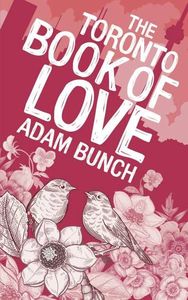Excerpt: Travel to a Disastrous Wedding Tradition in 1802 Toronto with Adam Bunch's The Toronto Book of Love
Toronto may be a young city on the world stage, but it's got plenty of fascinating history. No one knows that better than Adam Bunch, whose Toronto Book of the Dead explored the city's stories through its most unusual, strange, and fascinating deaths.
With Valentine's Day around the corner, Bunch has gone in the opposite direction for his new book, pivoting from death in Toronto to a (usually) more cheerful subject with The Toronto Book of Love (Dundurn Press). Showing the fiery side of the city's history, Bunch gathers true tales of romance, marriage, affairs, lust, jealousies, and soulmates. Movie stars, spies, prime ministers, and regular folks populate the pages and make for a rollicking read.
We're excited to continue our week of excerpts with a section from The Toronto Book of Love, courtesy of Dundurn Press. A totally fresh and fun take on Toronto history, it may make you feel a little more connected to know just how many people have fallen into and out of love, had a crush, gotten their heart broken, or met the one in Canada's biggest city.
Excerpt from The Toronto Book of Love:
Chapter 6: A Dangerous Charivari
Darkness had descended. It was an October evening in 1802. The people of York were settling down for the night. But not everything was still. A crowd of young men was creeping through the heart of the town. They wore disguises to conceal their identities — some in a crude parody of First Nations clothing — and carried with them an unlikely assortment of objects; they almost certainly had everything from pots and pans to horns and rifles. They were planning on making a racket.
Eugenia Willcocks had gotten married that day. She and Augustin Boiton de Fougères were an unlikely match: he was a French aristocrat; she was an Irish immigrant, the daughter of the former mayor of Cork. It was the kind of unusual international romance that foreshadowed Toronto’s future as a multicultural metropolis. But as the newlyweds spent their first night of matrimony together at her father’s home, those days were still far away. For now, York was still a sleepy British town on the quiet shores of Lake Ontario.
Or, at least, those shores were usually quiet. Once the crowd of young men reached the Willcocks house, it began. A terrible, cacophonous racket. Pots and pans and god knows what else banging and clattering and clanging together as loud as could be. Horns blowing. Guns firing off in the night. Yelling and whooping and every other noise those young men could think to make. The charivari had begun.
The raucous tradition of charivaris was established long before that loud evening in 1802. It can be traced back to Europe, and to the French settlers who brought the practice with them to New France. As settlers moved west into Upper Canada, the tradition spread with them. Charivaris generally happened on nights when an unusual or controversial marriage had taken place, like when an old man married a young woman, or two cultures mixed. It was a way of smoothing over the collective unease. A boisterous crowd would serenade the newlyweds with a hideous racket, interrupting the marital bliss of the wedding night to demand the happy couple emerge and buy them off with alcohol before they would agree to leave them in peace. Sometimes, the rabble-rousers might even get up onto the roof, blocking the chimney to smoke the newlyweds out.
The marriage of Eugenia Willcocks and Augustin Boiton de Fougères was certainly a remarkable one. Fougères was one of a few Upper Canadians who’d been born and raised in France. When the bloody terror of the French Revolution broke out, he’d taken up arms against the revolutionaries, joining an army that hoped to crush them and return the monarchy to the throne. It failed miserably, ending in a terrible massacre, and he was forced to flee. He headed to Upper Canada with a group of French aristocrat refugees. They settled along Yonge Street, well to the north of York — where the suburbs of Markham and Vaughan are today.
Now, the francophone Fougères had married into one of the province’s leading anglophone families. Eugenia was the daughter of William Willcocks. A former mayor and sheriff of Cork, he’d left Ireland behind to lead a group of settlers to Upper Canada. Things had gotten off to a very rough start: his first batch of settlers deserted him along the way; his second was captured at sea by the French navy. But after finally making it to York, he’d become one of the leading figures in the new town, serving as a judge and the first postmaster.
With things finally going well, Willcocks wrote to his family back home in Ireland, letting them know it was now safe to join him. Eugenia made the journey with her mother and two sisters, abandoning the life they’d known back home for a new one on the Canadian frontier.
Your CanLit News
Subscribe to Open Book’s newsletter to get local book events, literary content, writing tips, and more in your inbox
The young Willcocks women were quick to find love in their new home. Eugenia’s sister Phoebe would marry William Warren Baldwin — a doctor and architect who was destined to become one of the most influential politicians in Canada. And it wasn’t long before Eugenia met the adventurous French aristocrat Fougères. Soon, they were engaged to be married.
But not everyone in town seems to have felt entirely comfortable with the match. The French and English had long been mortal enemies, warring on and off for centuries. A French aristocrat marrying into a prominent anglophone family must have been disturbing to some people. And that’s exactly what a charivari was for: a hazing ritual to help the community accept a match that might otherwise cause discord.
Still, charivaris didn’t always go to plan. They could easily get out of hand. If the couple refused to come out and face the drunken mob, things could escalate. Some Upper Canadian charivaris ended with the couple being dragged out of their house, sometimes even tarred and feathered or tied to a rail and paraded around town. At least one bride was raped. On occasion, the charivaris could even end in death. Some terrified families fired their rifles into the unruly crowds. One young man was accidentally shot and killed by his fellow revellers. A Black man in St. Catharines was once brutally murdered during a charivari — even though his attackers were perfectly aware he wasn’t the groom they were after.
On that autumn night in York, with the charivari raging outside his front door, William Willcocks must have felt like his daughter and her new husband were in danger. He went to get his rifle. So did his son and his future son-in-law, William Warren Baldwin. Together, the three armed men burst from the home to confront the crowd. They threatened to open fire if everyone didn’t leave immediately.
Some did run off. Others were still there when the authorities were called and the constables arrived. One man was arrested. But by about ten o’clock, the troublemakers had dispersed. All was quiet once again.
For a while.
_____________________________________
This excerpt is taken from The Toronto Book of Love by Adam Bunch copyright © 2021 by Adam Bunch. Published by Dundurn Press. Reprinted with permission.
Adam Bunch is the author of The Toronto Book of the Dead, creator of the Toronto Dreams Project, host and co-creator of Canadiana, and a contributor to Spacing Magazine. His work earned an honourable mention for a Governor General’s History Award in 2012. Adam lives in Toronto.






